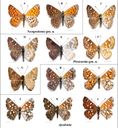Metalmarks
Riodinidae
Classification
- Phylum: Arthropoda
- Subphylum: Hexapoda
- Class: Insecta
- Order: Lepidoptera
- Superfamily: Papilionoidea
- Family: Riodinidae
Pronunciation
How to pronounce Riodinidae: /ˌraɪ.oʊˈdɪnɪdiː/
These audio files are automatically generated. While they are not always 100% accurate, they are a good starting point.
Images






Summary
Riodinidae, or metalmark butterflies, comprises around 1,400 species characterized by their vibrant metallic markings and varied ecological adaptations, especially notable for their mutualistic associations with ants and unique feeding habits.
Physical Characteristics
Small to medium-sized species, from 12 to 60 mm wingspan. Wing coloration ranges from muted in temperate species to vibrant iridescent blues and greens in tropical species, often featuring golden or silvery metallic spots.
Identification Tips
Males exhibit reduced forelegs with uniquely shaped coxae. Characteristic venation in hindwings, including a thickened costa and a short humeral vein. The pair of legs of males is much shorter than those of the pterothorax.
Habitat
Varied habitats, with a strong focus on tropical rainforests in South America. Species are often found in areas that are ecologically diverse.
Distribution
About 1,400 species globally, with the highest diversity in the Neotropics. 29 species have been recorded in North America, with most of the family occurring across most continents, including Nearctic, Palearctic, Australasian, Afrotropic, and Indomalayan realms.
Diet
Caterpillars feed on a variety of plants, primarily consuming young leaves or flowers from over 40 families, including Araceae, Asteraceae, Bromeliaceae, and others. Some species are predatory, feeding on other insect larvae.
Life Cycle
Eggs are often round and flattened, caterpillars are generally hairy and plump, and pupae are attached with silk. Larvae are typically the overwintering stage.
Reproduction
Many species engage in mutualistic relationships with ants, where larvae are tended and defended by ant associates. Myrmecophily is present in numerous species of Riodinidae, similar to some Lycaenidae.
Predators
Predation on some larval stages occurs, with examples of larvae preying on members of the family Membracidae and scale insects.
Ecosystem Role
Riodinidae can play significant roles in pollination and serve as prey for various species in their ecosystems. Some larvae are involved in symbiotic relationships with ants.
Economic Impact
Considered pests in low significance. Some species may feed on economically important plants such as guava, bromeliads, or orchids.
Collecting Methods
- Netting
- Trapping
- Light trapping
Preservation Methods
- Pinning
- Drying
- Freezing
Evolution
Riodinidae has been historically classified alongside Lycaenidae, but is now accepted as a distinct family primarily due to morphological and molecular phylogenetic data.
Similar Taxa
- Lycaenidae
- Papilionidae
- Erycinidae
Misconceptions
Often considered a subfamily of Lycaenidae or part of the defunct family Erycinidae. Their mimicry traits are sometimes misunderstood in terms of ecological relationships.
Tags
- Butterflies
- Metalmarks
- Riodinidae
- Lepidoptera
- Pollination